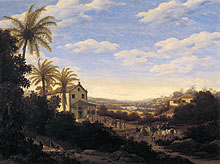
Frans Post, Brazilian Landscape with Dancing Natives and a Chapel, 17th century. Oil on wood, 43.2 x 57.8 cm. Collection of Patricia Phelps de Cisneros, Caracas. Photo by Mark Morosse.

The selection of objects from Brazil’s indigenous cultures represents only a fraction of the visual riches of native peoples from many parts of the country. The flute-mask of the Wayana people (Carib-speaking groups from the extreme north of Brazil) was designed for use in male initiation ceremonies. Also from Wayana territory is the feathered back plate made from the plumes of six types of birds. It is worn in conjunction with the ritual initiation mask created from feathers and vegetal materials. Both of these pieces possess cosmological symbolism. The ritual arrows of the Wayana are both utilitarian and spiritualized weapons that represent the symbolic links between humans and their prey.
The big-face mask is worn in ceremonies held in anticipation of warfare by the Tapirapé people, who inhabit the northeast regions of the inland state of Mato Grosso. This mask, representing male power in warfare, is thought to ritually possess the soul of an enemy warrior named Kayapó. Tapirapé men and boys also fashion small wax dolls that embody the supernatural spiritual force called topu; these personifications of storms, capable of launching lightning bolts at humans, travel on small canoes. All of the ritual objects created by this and other groups are intimately connected to their creation mythology and cosmological legends. Their spiritualized quality removes them from the conventional, aestheticized qualities that Westerners refer to as art.
—Edward J. Sullivan